-

12/11/2021
Tim Yasick is a truck driver from La Crosse, Wisconsin. He lives with his wife, a puppy, and three cats. Tim spends most of his time on the road, only interacting with people at gas stations and truck stops, and this has allowed him to get through the pandemic without getting sick. In this interview, Tim discusses his experiences on the road, with mask mandates differing from state to state, and at home, where he just got married this June. He feels that accurate information and understanding each other are going to go much further in ending this pandemic than politics or vaccine mandates. He feels a change of heart is the only way.
-
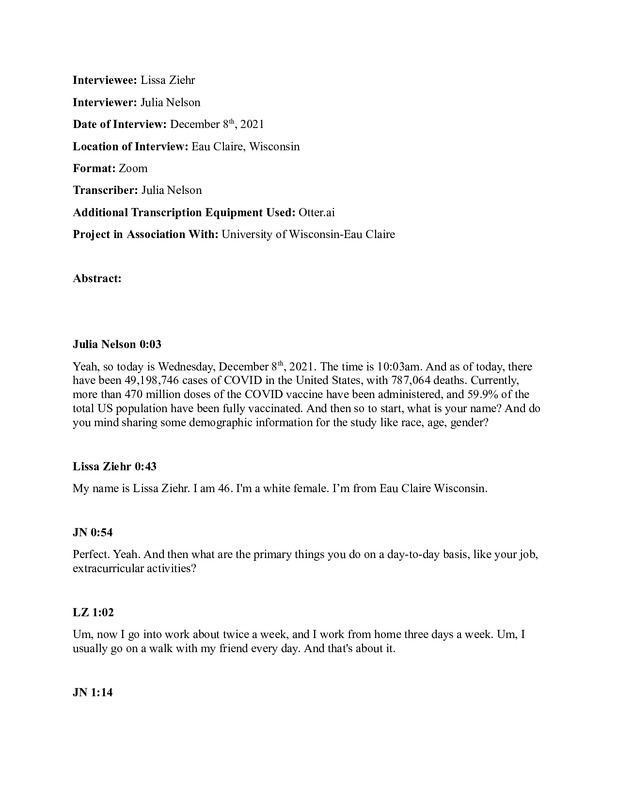
12/08/2021
-
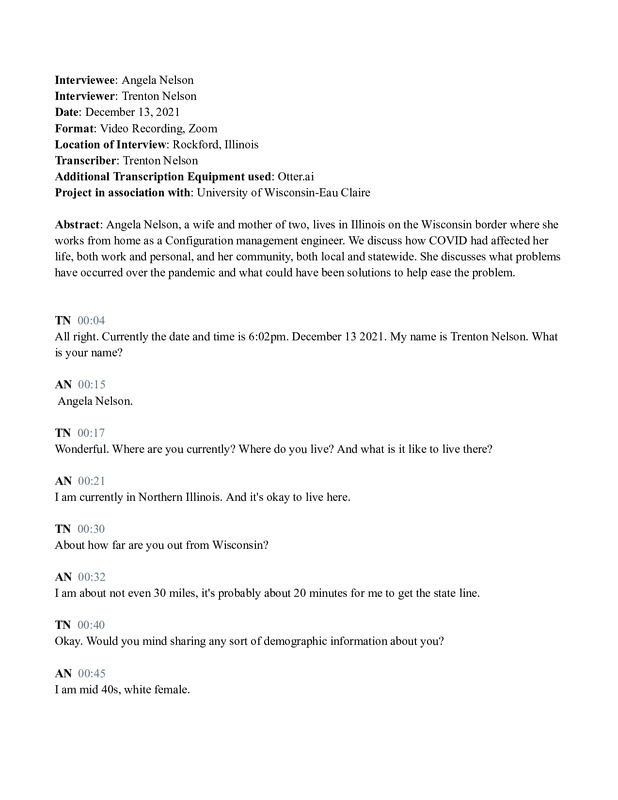
12/13/2021
Angela Nelson, a wife and mother of two, lives in Illinois on the Wisconsin border where she works from home as a Configuration management engineer. We discuss how COVID had affected her life, both work and personal, and her community, both local and statewide. She discusses what problems have occurred over the pandemic and what could have been solutions to help ease the problem.
-
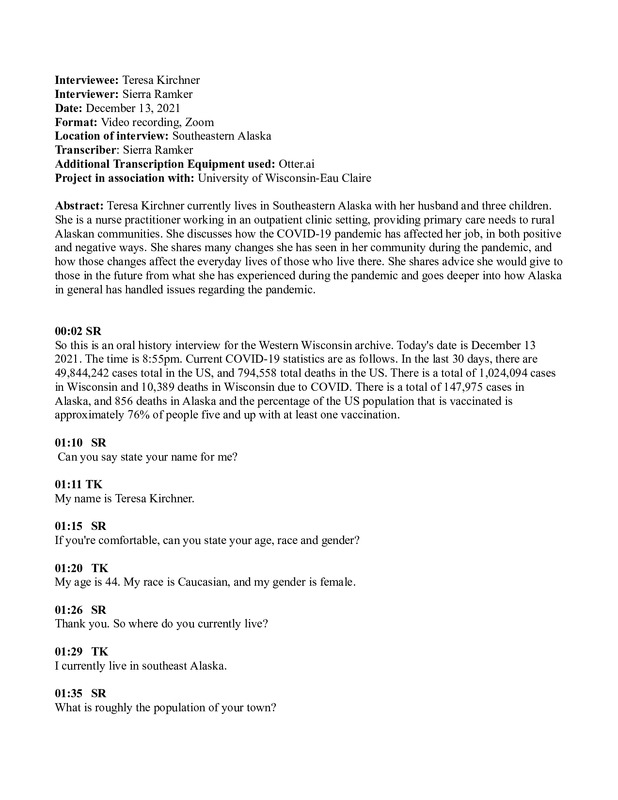
12/13/2021
Teresa Kirchner currently lives in Southeastern Alaska with her husband and three children. She is a nurse practitioner working in an outpatient clinic setting, providing primary care needs to rural Alaskan communities. She discusses how the COVID-19 pandemic has affected her job, in both positive and negative ways. She shares many changes she has seen in her community during the pandemic, and how those changes affect the everyday lives of those who live there. She shares advice she would give to those in the future from what she has experienced during the pandemic and goes deeper into how Alaska in general has handled issues regarding the pandemic.
-
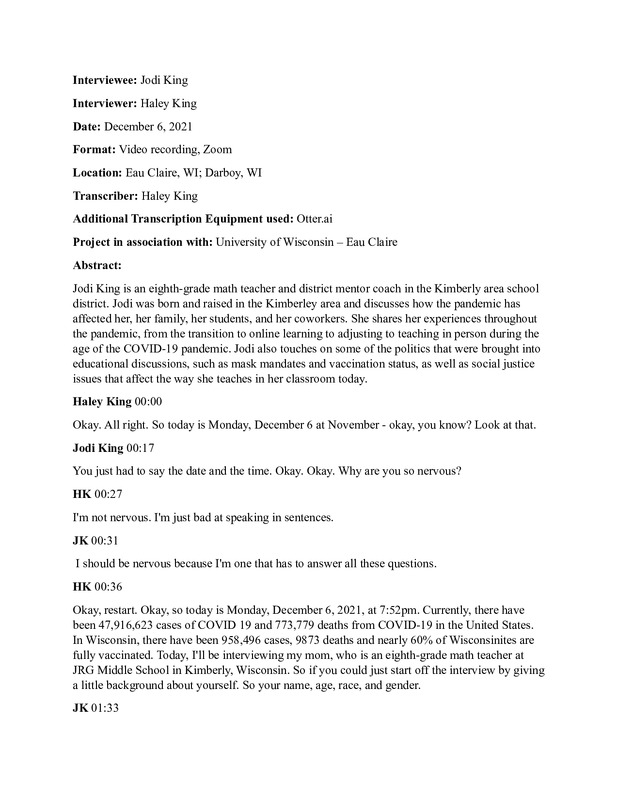
12/06/2021
Jodi King is an eighth-grade math teacher and district mentor coach in the Kimberly area school district. Jodi was born and raised in the Kimberly area and discusses how the pandemic has affected her, her family, her students, and her coworkers. She shares her experiences throughout the pandemic, from the transition to online learning to adjusting to teaching in person during the age of the COVID-19 pandemic. Jodi also touches on some of the politics that were brought into educational discussions, such as mask mandates and vaccination status, as well as social justice issues that affect the way she teaches in her classroom today.
-
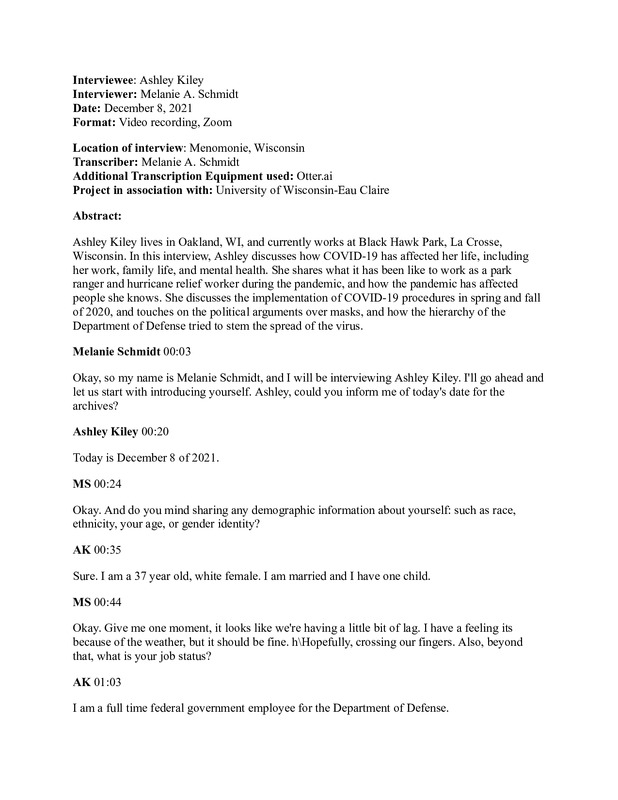
12/08/2021
Ashley Kiley lives in Oakland, WI, and currently works at Black Hawk Park, La Crosse, Wisconsin. In this interview, Ashley discusses how COVID-19 has affected her life, including her work, family life, and mental health. She shares what it has been like to work as a park ranger and hurricane relief worker during the pandemic, and how the pandemic has affected people she knows. She discusses the implementation of COVID-19 procedures in spring and fall of 2020, and touches on the political arguments over masks, and how the hierarchy of the Department of Defense tried to stem the spread of the virus.
-
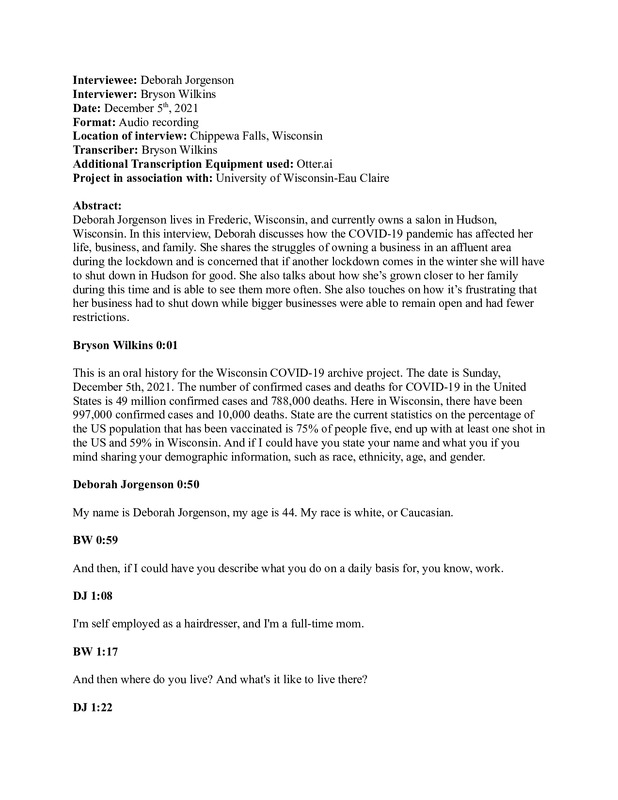
12/05/2021
Deborah Jorgenson lives in Frederic, Wisconsin, and currently owns a salon in Hudson, Wisconsin. In this interview, Deborah discusses how the COVID-19 pandemic has affected her life, business, and family. She shares the struggles of owning a business in an affluent area during the lockdown and is concerned that if another lockdown comes in the winter she will have to shut down in Hudson for good. She also talks about how she’s grown closer to her family during this time and is able to see them more often. She also touches on how it’s frustrating that her business had to shut down while bigger businesses were able to remain open and had fewer restrictions.
-
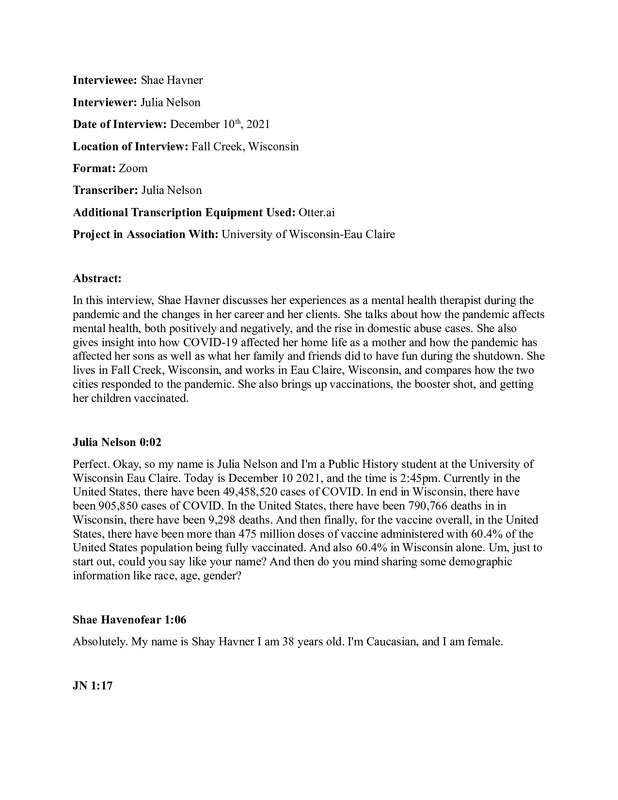
12/10/2021
In this interview, Shae Havner discusses her experiences as a mental health therapist during the pandemic and the changes in her career and her clients. She talks about how the pandemic affects mental health, both positively and negatively, and the rise in domestic abuse cases. She also gives insight into how COVID-19 affected her home life as a mother and how the pandemic has affected her sons as well as what her family and friends did to have fun during the shutdown. She lives in Fall Creek, Wisconsin, and works in Eau Claire, Wisconsin, and compares how the two cities responded to the pandemic. She also brings up vaccinations, the booster shot, and getting her children vaccinated.
-
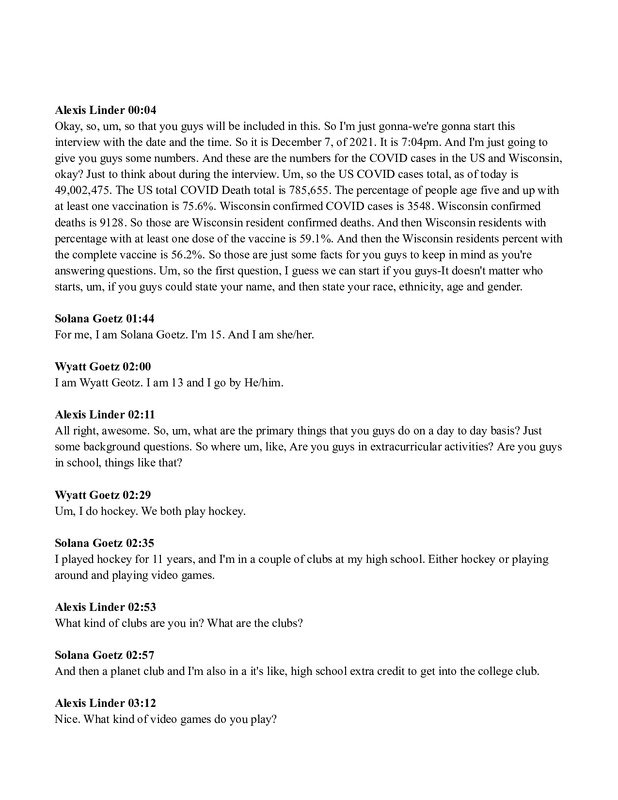
12/07/2021
-
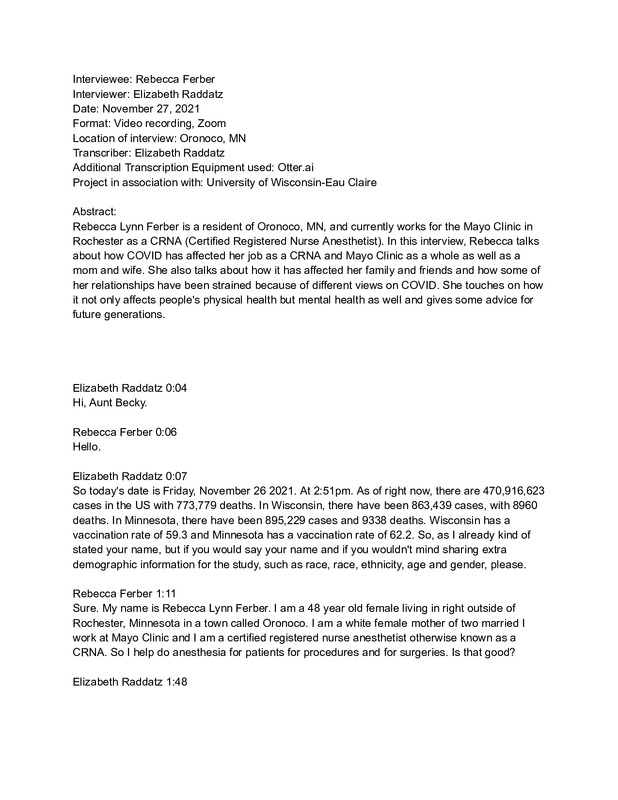
11/27/2021
Rebecca Lynn Ferber is a resident of Oronoco, MN, and currently works for the Mayo Clinic in Rochester as a CRNA (Certified Registered Nurse Anesthetist). In this interview, Rebecca talks about how COVID has affected her job as a CRNA and Mayo Clinic as a whole as well as a mom and wife. She also talks about how it has affected her family and friends and how some of her relationships have been strained because of different views on COVID. She touches on how it not only affects people's physical health but mental health as well and gives some advice for future generations.
-
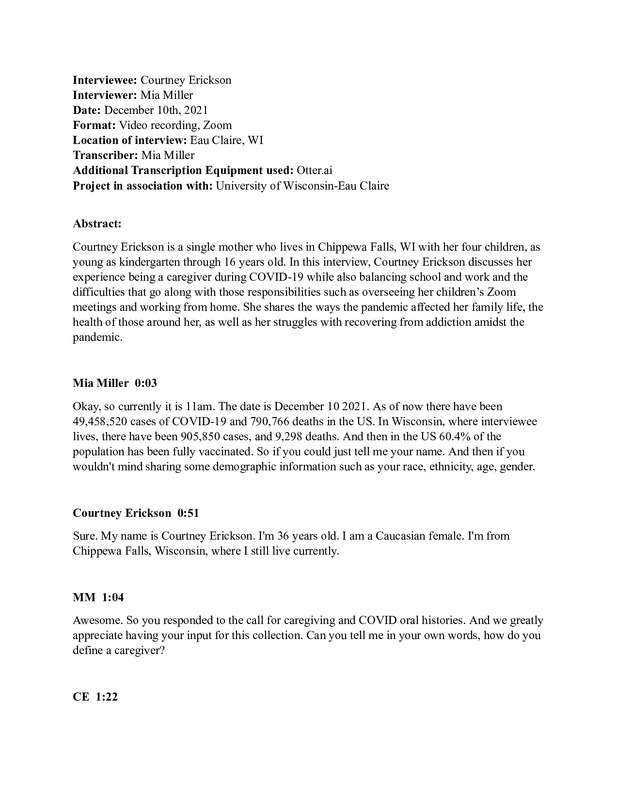
12/10/2021
Courtney Erickson is a single mother who lives in Chippewa Falls, WI with her four children, as young as kindergarten through 16 years old. In this interview, Courtney Erickson discusses her experience being a caregiver during COVID-19 while also balancing school and work and the difficulties that go along with those responsibilities such as overseeing her children’s Zoom meetings and working from home. She shares the ways the pandemic affected her family life, the health of those around her, as well as her struggles with recovering from addiction amidst the pandemic.
-
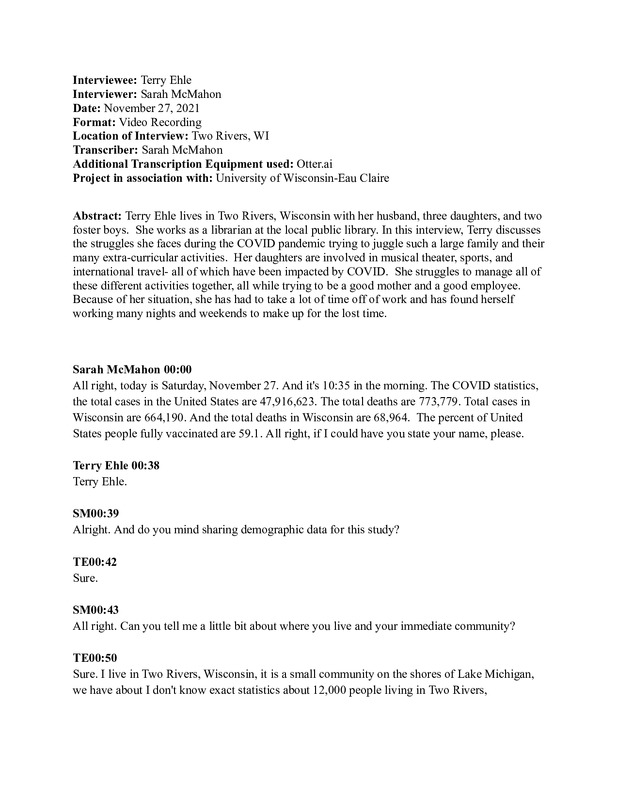
11/27/2021
Terry Ehle lives in Two Rivers, Wisconsin with her husband, three daughters, and two foster boys. She works as a librarian at the local public library. In this interview, Terry discusses the struggles she faces during the COVID pandemic trying to juggle such a large family and their many extra-curricular activities. Her daughters are involved in musical theater, sports, and international travel- all of which have been impacted by COVID. She struggles to manage all of these different activities together, all while trying to be a good mother and a good employee. Because of her situation, she has had to take a lot of time off of work and has found herself working many nights and weekends to make up for the lost time.
-
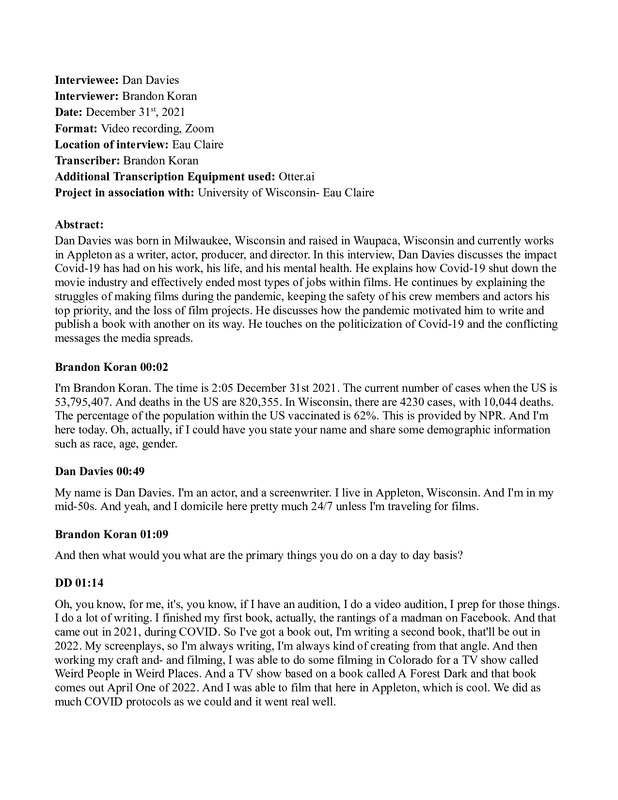
12/31/2021
Dan Davies was born in Milwaukee, Wisconsin, raised in Waupaca, Wisconsin, and works in Appleton as a writer, actor, producer, and director. In this interview, Dan Davies discusses the impact Covid-19 has had on his work, life, and mental health. He explains how Covid-19 shut down the movie industry and effectively ended most types of jobs within films. He continues by explaining the struggles of making films during the pandemic, keeping the safety of his crew members and actors his top priority, and the loss of film projects. He discusses how the pandemic motivated him to write and publish a book with another on its way. He touches on the politicization of Covid-19 and the media's conflicting messages.
-
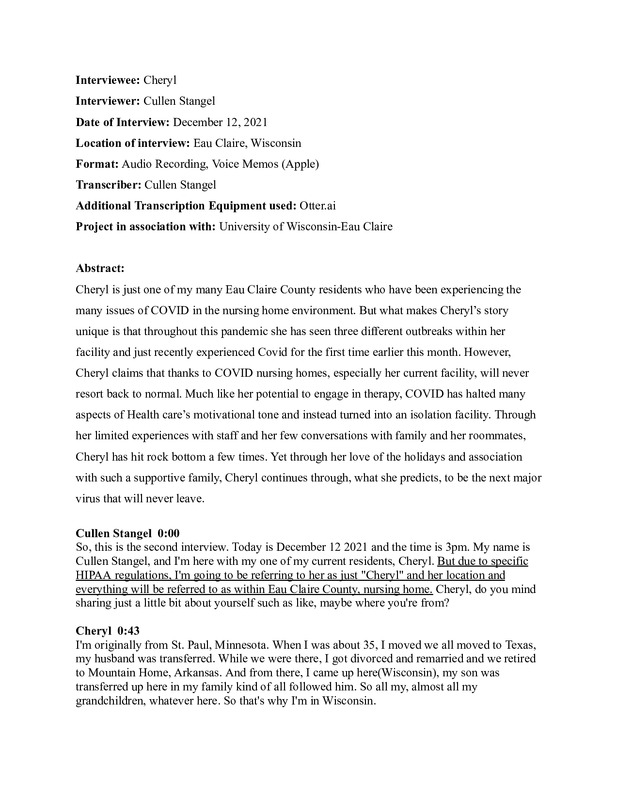
12/12/2021
Cheryl is just one of my many Eau Claire County residents who have been experiencing the many issues of COVID in the nursing home environment. But what makes Cheryl’s story unique is that throughout this pandemic she has seen three different outbreaks within her facility and just recently experienced Covid for the first time earlier this month. However, Cheryl claims that thanks to COVID nursing homes, especially her current facility, will never resort back to normal. Much like her potential to engage in therapy, COVID has halted many aspects of Health care’s motivational tone and instead turned into an isolation facility. Through her limited experiences with staff and her few conversations with family and her roommates, Cheryl has hit rock bottom a few times. Yet through her love of the holidays and association with such a supportive family, Cheryl continues through, what she predicts, to be the next major virus that will never leave.
-
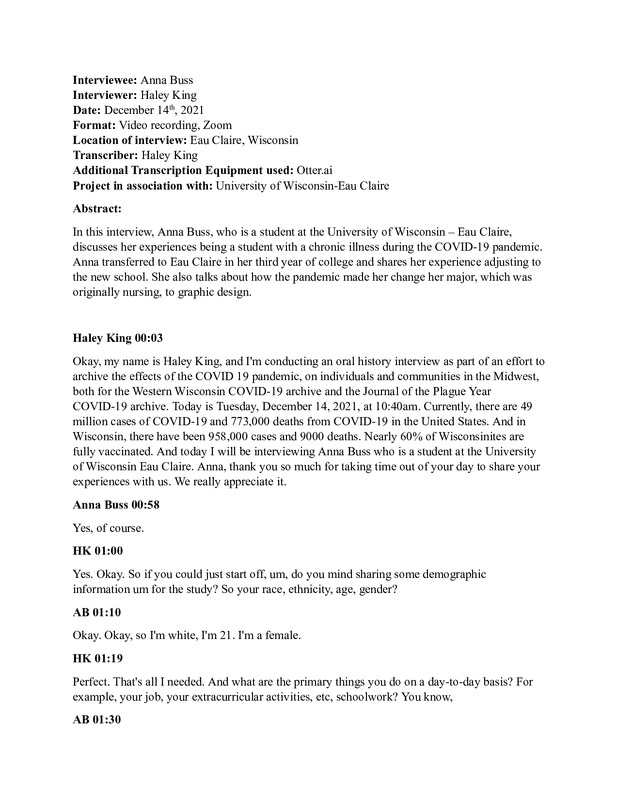
12/14/2021
In this interview, Anna Buss, who is a student at the University of Wisconsin – Eau Claire, discusses her experiences being a student with a chronic illness during the COVID-19 pandemic. Anna transferred to Eau Claire in her third year of college and shares her experience adjusting to the new school. She also talks about how the pandemic made her change her major, which was originally nursing, to graphic design.
-
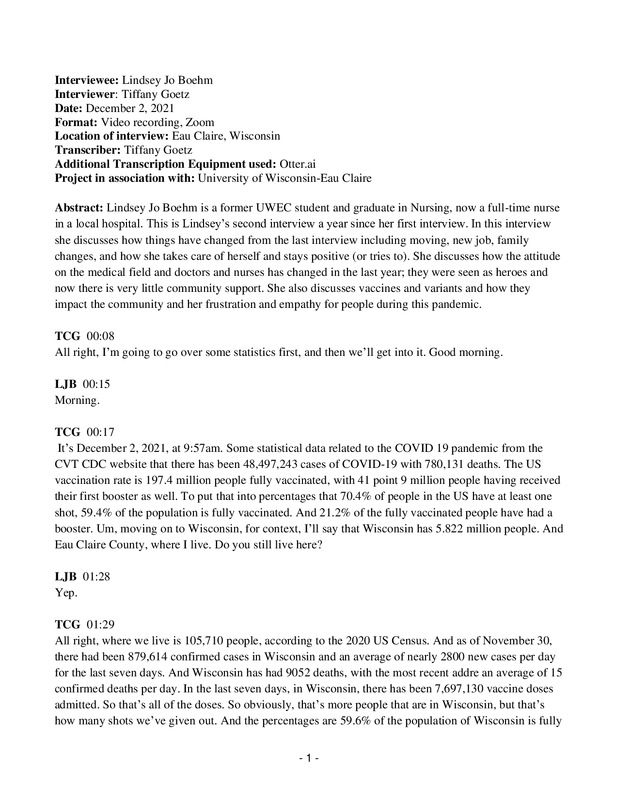
12/02/2021
Lindsey Jo Boehm is a former UWEC student and graduate in Nursing, now a full-time nurse in a local hospital. This is Lindsey’s second interview a year since her first interview. In this interview, she discusses how things have changed from the last interview including moving, a new job, family changes, and how she takes care of herself and stays positive (or tries to). She discusses how the attitude in the medical field and doctors and nurses has changed in the last year; they were seen as heroes and now there is very little community support. She also discusses vaccines and variants and how they impact the community and her frustration and empathy for people during this pandemic.
-
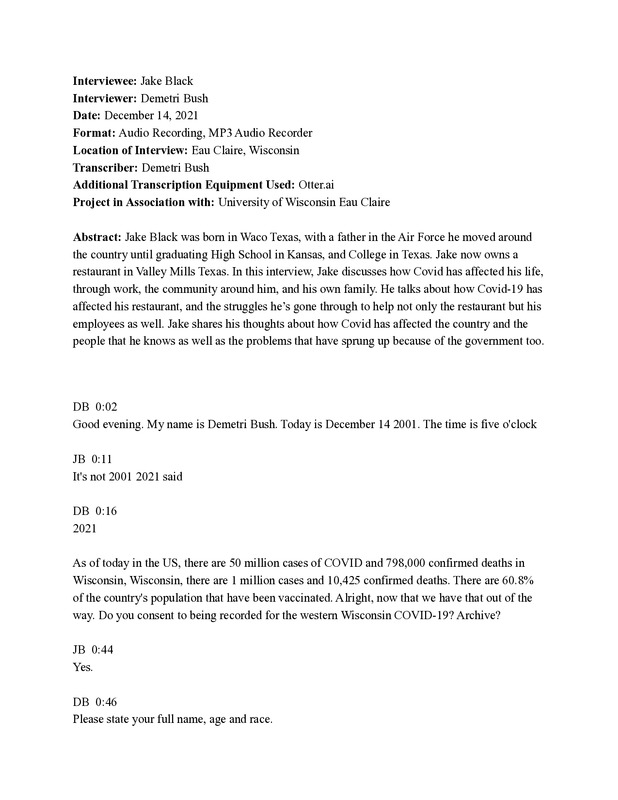
12/14/2021
Jake Black was born in Waco Texas, with a father in the Air Force he moved around the country until graduating High School in Kansas, and College in Texas. Jake now owns a restaurant in Valley Mills, Texas. In this interview, Jake discusses how Covid has affected his life, through work, the community around him, and his own family. He talks about how Covid-19 has affected his restaurant and the struggles he’s gone through to help not only the restaurant but his employees as well. Jake shares his thoughts about how Covid has affected the country and the people that he knows as well as the problems that have sprung up because of the government too.
-
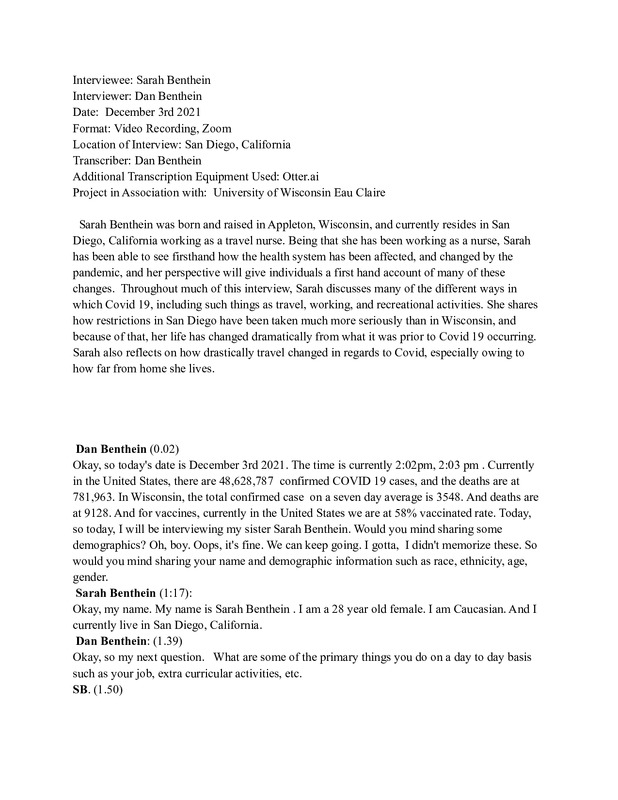
12/03/2021
Sarah Benthein was born and raised in Appleton, Wisconsin, and currently resides in San Diego, California working as a travel nurse. Being that she has been working as a nurse, Sarah has been able to see firsthand how the health system has been affected, and changed by the pandemic, and her perspective will give individuals a first-hand account of many of these changes. Throughout much of this interview, Sarah discusses many of the different ways in which Covid 19, including such things as travel, working, and recreational activities. She shares how restrictions in San Diego have been taken much more seriously than in Wisconsin, and because of that, her life has changed dramatically from what it was prior to Covid 19 occurring. Sarah also reflects on how drastically travel changed in regards to Covid, especially owing to how far from home she lives.
-
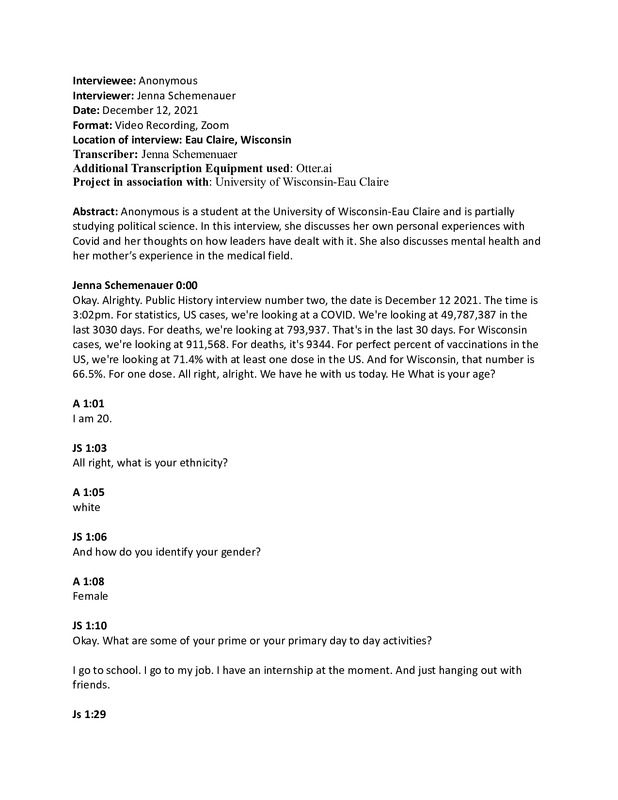
12/12/2021
Anonymous is a student at the University of Wisconsin-Eau Claire and is partially studying political science. In this interview, she discusses her own personal experiences with Covid and her thoughts on how leaders have dealt with it. She also discusses mental health and her mother’s experience in the medical field.
-
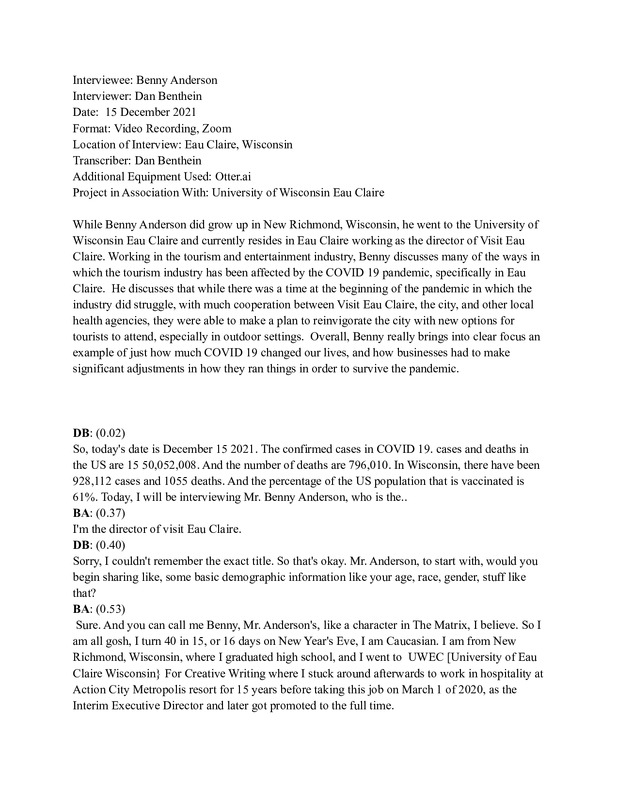
12/15/2021
While Benny Anderson did grow up in New Richmond, Wisconsin, he went to the University of Wisconsin Eau Claire and currently resides in Eau Claire working as the director of Visit Eau Claire. Working in the tourism and entertainment industry, Benny discusses many of the ways in which the tourism industry has been affected by the COVID-19 pandemic, specifically in Eau Claire. He discusses that while there was a time at the beginning of the pandemic in which the industry did struggle, with much cooperation between Visit Eau Claire, the city, and other local health agencies, they were able to make a plan to reinvigorate the city with new options for tourists to attend, especially in outdoor settings. Overall, Benny really brings into clear focus an example of just how much COVID-19 changed our lives, and how businesses had to make significant adjustments in how they ran things in order to survive the pandemic.
-

2023-03-20
What Happened on March 11th, 2020
-
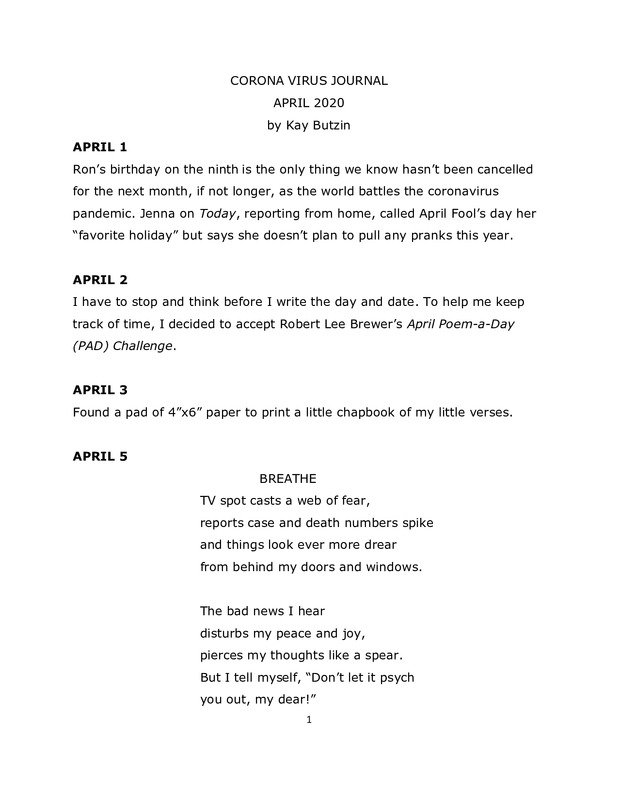
2020-04-01
The essay is composed of entries from my daily journal during the month of April 2020, at the beginning of the pandemic quarantine. It shares the perspective of my partner and me, retired senior citizens in Up North Michigan.
-
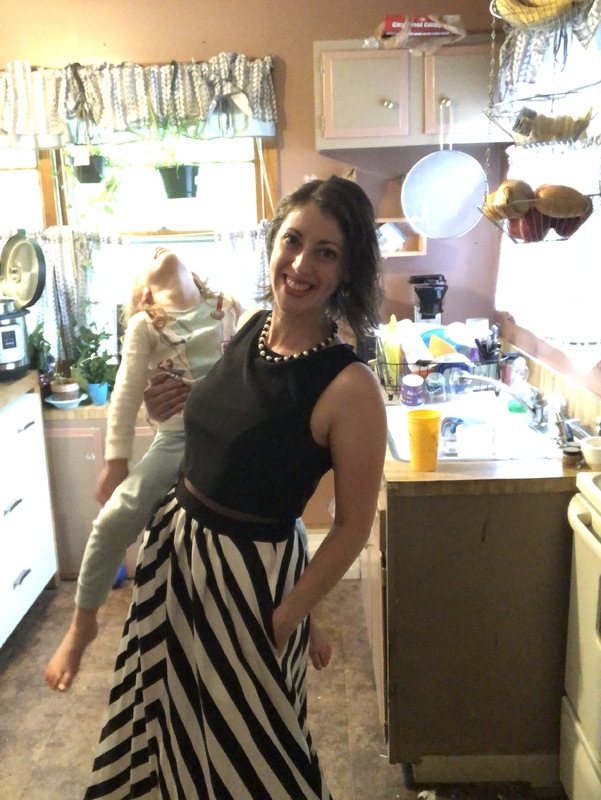
2020-03-19
"Since everyday is Corona Casual now, I propose we start doing 'Formal Friday.' Break out the tux or gown, do your hair, and settle in for a fancy day at home."
I posted that on Facebook on Thursday, March 19, 2020. The next day, I shared a photo of myself in a cocktail dress, pearls, and lipstick, laptop balanced on my knee, chaotic home office behind me.
In the weeks that followed, I would post a reminder on Thursday, and on Friday folks would post photos of themselves in their finery. These were friends from all aspects of my life, people who didn't know each other, using the hashtag #formalfriday and adding a little levity to an anxiety ridden time.
For me, it was one of the only bright spots. Work from home started March 12th. Five days before that, my husband had informed me our marriage wasn't working. And five days after, my mom went into the hospital, where she was diagnosed with stage 4 breast cancer. Over the course of 10 days, my world had been ripped out from under me. The emotional isolation was crushing. Compounded with the physical and social isolation - I was living each day on the verge of collapse.
But on Fridays, I would put on makeup, jewelry, and a gown and pretend that everything was hunky dory for social media. That my level of fear, of anxiety, of panic were on the same level as everyone else's. I would take a photo, sometimes with my daughter, and post on Facebook. Then I would take off the sparkles and finery and return to the dull reality of leggings and dread.
Formal Friday went on for eleven weeks. I saved my favorite dress for last: A full-length gown with a black and white striped skirt (it has pockets!) and crop-top illusion. In the photo, my daughter is in her pajamas because we had given up on making her get dressed by then. I'm clenching onto her and she's flopped backward, totally over the whole thing. There's a smile on my face that doesn't reach my eyes.
After I posted it, I had multiple friends reach out to ask if I was OK. We were three months into a two-week quarantine, yet the pandemic was a solid third on the list of things I was most worried about. The strain was starting to show on my body, in my face.
Looking back at the photos now, I think about the illusion of social media and how easy it is to pretend that what someone posts is reflective of their full reality. I was going through the most challenging time in my life, but based on what I put on Facebook, I had enough joy to play dress-up once a week.
At the same time... I still had enough joy to play dress-up once a week. And it brought me joy to see other people do the same. Seeing my friends, and friends of friends, and screenshots of zoom meetings, where people were in suits, or gowns, or just putting on a little make-up because that's all they could muster, kept a flame of happiness glowing inside me and helped me get through those first eleven weeks. It was silly, it wasn't a representation of reality, but when my whole world was on fire, it was nice to feel beautiful with friends.
-
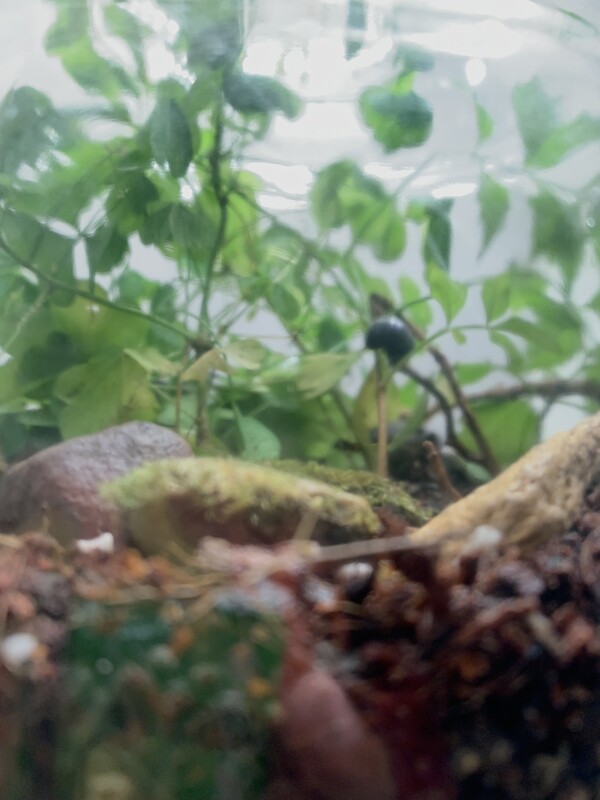
2021-09-06
Covid took us away from everything and reality was hard to cope with. I decided to retreat into nature. The struggle was that I hated being in my house and I couldn't stay outside forever. I decided that I would bring nature indoors and started to make terrariums. I was able to exercise, practice a hobby, create art. and safely quarantine all at once.
-
2020-03-13
March 13, 2020 was a memorable day for all of us. It's the day we got the call that the schools would shut down for who knows how long due to the virus that was rapidly spreading. It was a scary time for everyone due to all of the unknowns. We were stuck in our houses for months with nothing to do. Being quarantined did teach me a lot of things, such as how to have fun at home. Once the restrictions got lifted, and we were allowed to see our friends, I remember spending everyday outside, finding our own ways to have fun since everything else was closed. 2020 was year none of us will forget. We found ways to make light of a horrible situation.
-

2021-11-30
This video was put together by our development department. It showcases the work Project Hospitality has done during the pandemic.
-

2020-03-13
During the Pandemic, I actually had the time to sit and reflect on my religion and take time to learn from Allah swt. I strengthened my relationship with him and became a better Muslim throughout these times during the pandemic. The pandemic has provided an unexpected opportunity for many individuals to deepen their connection to their faith, again, including myself. As I found myself with more time for introspection and reflection, I was able to delve into the teachings and practices of Islam in a way that I hadn't before. This period of isolation allowed me to prioritize my spiritual growth and strengthen my relationship with Allah. I am grateful for this newfound connection to Islam and am committed to continuing my journey of Islam.
"None of you truly believes until he loves for his brother what he loves for himself." (Sahih Al-Bukhari, Book 2, Hadith 12)
This hadith emphasizes the importance of treating others as we would like to be treated, which is a fundamental principle of Islam. It highlights the idea that our faith is not just about personal piety, but also about fostering a sense of community and compassion for others. By loving and caring for our fellow human beings, we can strengthen our connection to both our faith and to each other, which is especially important during times of hardship and uncertainty like the pandemic.
-
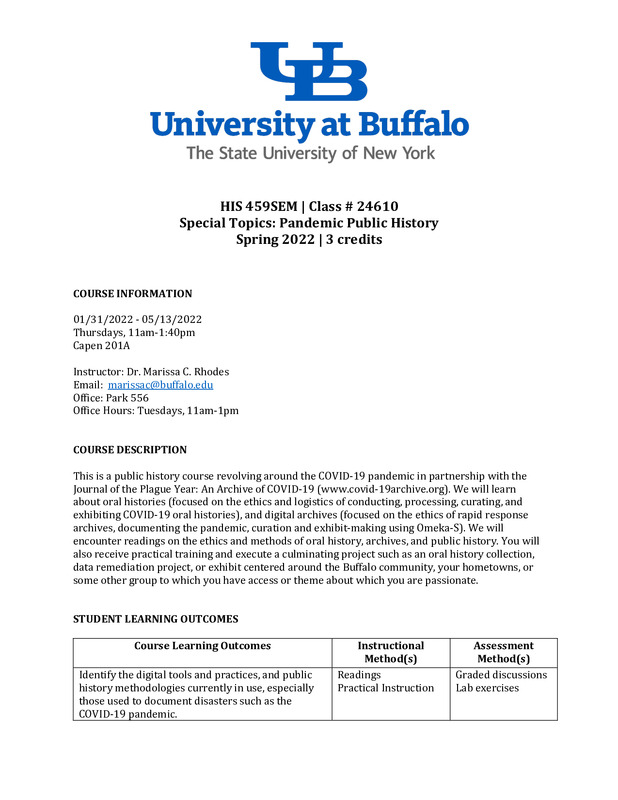
2022-01-31
This is the syllabus from Dr. Rhodes' HST459 class at the University at Buffalo. From the syllabus:
"This is a public history course revolving around the COVID-19 pandemic in partnership with the Journal of the Plague Year: An Archive of COVID-19 (www.covid-19archive.org). We will learn about oral histories (focused on the ethics and logistics of conducting, processing, curating, and exhibiting COVID-19 oral histories), and digital archives (focused on the ethics of rapid response archives, documenting the pandemic, curation and exhibit-making using Omeka-S). We will encounter readings on the ethics and methods of oral history, archives, and public history. You will also receive practical training and execute a culminating project such as an oral history collection, data remediation project, or exhibit centered around the Buffalo community, your hometowns, or some other group to which you have access or theme about which you are passionate."
Students in the class submitted items to the archive, created oral histories and conducted projects within JOTPY. This will be linked to those items.
-
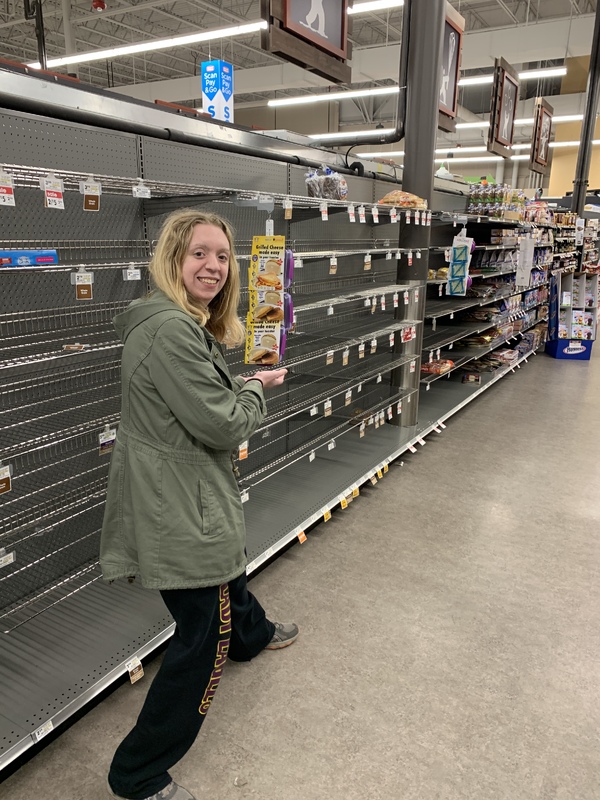
2020-03-13
Before this was taken, I found out school would be online for the rest of the semester heading home for spring break plus two weeks. Boy if only I knew what I know now...
-
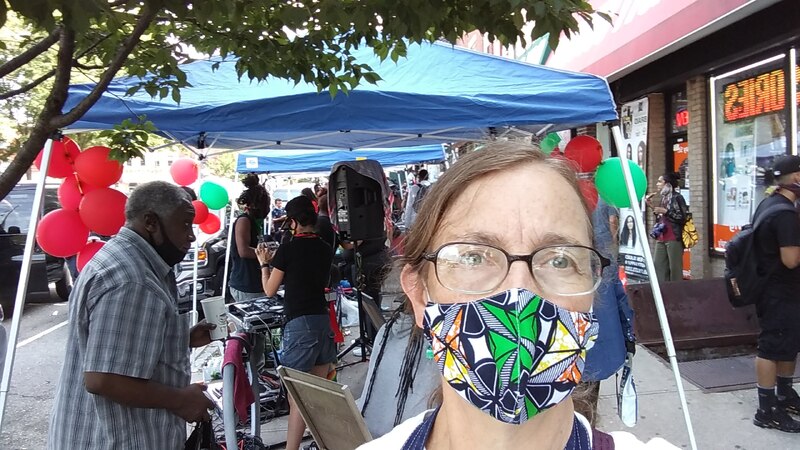
2020-06-22
These photos depict some of the events and activities I was part of during the summer of 2020. I marched to protest the killings of innocent black men by police, I attended a street festival held in honor of Eric Garner (on the anniversary of his death), I worked at a Brooklyn Greenmarket doing "covid support" (a very stressful job), and I visited the peaceful grounds of Snug Harbor, wearing my favorite polka-dot mask made by a friend.
-
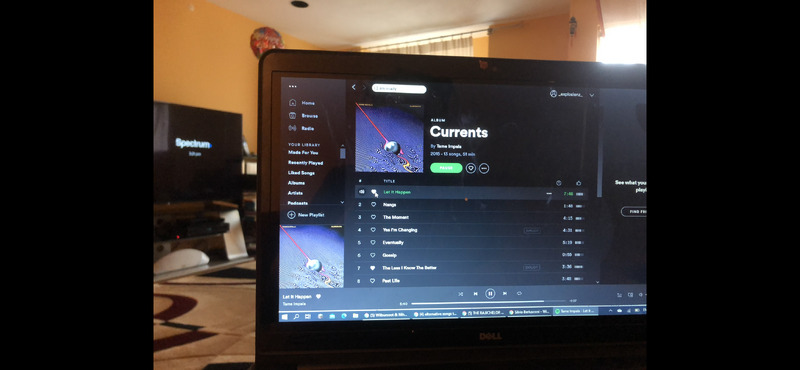
2020-06-06
During the COVID-19 lockdown, I was bored. I started to listen to an unprecedented amount of music. Including music from the artist Tame Impala. This photo shows me listening to his “Currents” album via Spotify. Currents is now one of my favorite albums of all time. Everytime I listen to a song from it, I think back to 2020 and as a result, that time holds a sentimental value to me.
-
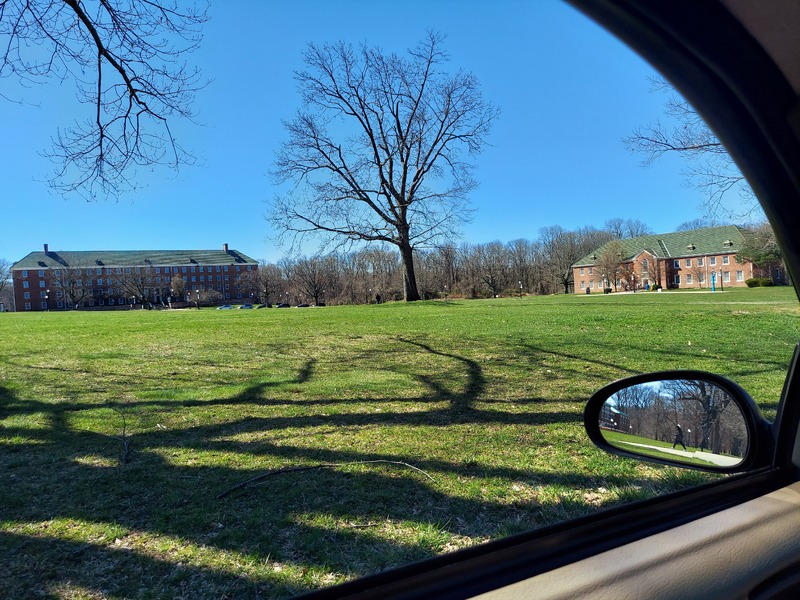
2023-03-30
My family and I were shown immense grace as the world endured the heart wrenching sorrow of the COVID-19 pandemic. May those whose lives were stolen by the coronavirus live forever in memory, and rest in eternal peace.
At the onset of my second Freshman semester, the chatter among friends included ignorant musings such as: "what would happen if we got it?”, and my favorite, “the virus would NEVER come to the island.” Before Costco lines evoked Walmart on Black Friday, and up-to-the-minute death tolls became the linchpin of our media diet, the Bayonne Bridge signified a seemingly impenetrable chasm safeguarding Staten Island from a quarantined cruise ship in February 2020; because obviously airborne particles don’t pay tolls, right?
A strange sense of wonder and excitement overtook the CSI campus on March 11, 2020: the day Gov. Cuomo announced CUNY & SUNY schools would “pause” in-person instruction. I'll never forget hearing the announcement on radio before walking to class for the last time until September 20, 2021. As I drove down Loop Road, a group of students (presumably upperclassman) cheered while blasting music on the Great Lawn. If those students truly were upperclassman, their dancing in the face of uncertainty would spite the commencement celebration they would never receive. I suspect a webpage and some pre-recorded speeches is an inutile stand-in for sitting among thousands of graduates on that very lawn.
In tandem with devastation, panic, and uncertainty, the pandemic thrust society into a hard reset. So much of life is spent planning, yearning, and working towards the future - all of which are meaningless novelties to a hellacious virus. To survive the pandemic, besides evading COVID by way of masks, social distancing, and grace from above, each of us had to sift the remnants of our livelihoods to make out what our “new” present would look like.
I thrived through the pandemic with music blasting, self-reflection, and a sense of liberation. Family bonds grew stronger, passion projects were completed, and for the first time in a decade, my life felt tranquil. I am repulsed by the fact that while millions took their final breath, businesses shuttered for good, and anxiety tormented the world, I found inner peace reminiscent of my childhood summers. Eerily, I vividly recall sitting in the basement of 2N during a 8am Geology class wishing for, “all this crap to end”, and lamenting, “why didn’t I go to SNHU or some college online?” I guess someone got their wish, and dragged humanity down with him.
My father was the only non-essential worker in the house; he didn’t get that fancy paper from the state which supposedly let you free if cops pulled you over. We spent the first full day of lockdown scouring local stores for the coveted (and effective) N95 masks. At a time when the CDC told people to not wear masks so medical professionals had supplies, we were on a mission to guarantee we had protection for the long haul. My family recognized that the “pause” would not be a 1 to 2 month patty cake. My father was adamant his Window Cleaning & Power Washing business would collapse from the indefinite closures of his commercial clients.
Our first purchase was the last 3-pack of Milwaukee N95s with those gaudy exterior respirators from homespun Garber’s Hardware. The ever-jovial gentlemen behind the counter adamantly said something to the effect of, “we’re gonna be here ’till they tell us to shut them doors.” 3 masks wouldn’t cut it, so we continued down the way to ye olde Sherwin Williams; where the employee had no suspicion we needed a 20-count box of 3M's finest for anything other than some recreational spray painting. Mask wearing wasn’t en vogue just yet.
Those masks were needed when my Uncle could not get out of bed at 1:30pm the following Saturday. He worked the night prior, Friday the 13th, at his second job as a bouncer in Manhattan. On Saturdays he would saunter out of bed by 10:45 the latest; but here he was: frozen in bed, voice hoarse, and coughing like a smoker. I threw on the 95 and nitrile gloves just to speak to him from the hallway. That day was also the first time I ventured out in full biohazard regalia. I still remember the condescending scowls at my neighborhood’s second rate deli counter.
The treatment advice the CDC hotline provided was to load up on Extra Strength Tylenol and guzzle water like there was no tomorrow. Thankfully my Uncle did see tomorrow and recovered in about 5 days. While my Dad and I kept our distance as my mother tended to the patient, we realized there must be a fruitful pastime besides burying our eyes in CNN coverage all day.
My father, perpetually seeking the next project, came to the realization that, in plain english: we needed a pool table.
When I was 6 years old, my father built a pool table out of wood when he was working for a contracting firm that operated in what is now Brooklyn’s Industry City. At 9 feet It conveniently sat atop our giant dinning room table. It was a gorgeous deep blue with every authentic accoutrement short of nicotine-reeking cloth. The table lasted about 8 months until my mom wanted her dining room back, fair enough. For a long time that table felt like a fever dream. After the it departure it was seldom mentioned; the balls and commemorative Coca-Cola cuestick sat dormant in the far reaches of our old home.
The biggest hurdle to this project was space. The only feasible location was the unfurnished room in the back of our basement. The room experienced iterations as a screen-print emulsion lab, woodshop, actual chocolate factory, punching bag area, and video recording studio. After countless YouTube tutorials, including a Filipino gentleman building an unleveled table where all balls rolled to one side, we ventured to Lowe’s “Indoor Lumber Yard” to rekindle the magic of 2007.
We sourced only the finest un-warped 2x4s and the purest synthetic wood crafted by the hands of man: Unfinished MDF Board. The 97 inch composite wouldn't fit down the basement stairwell, so we asked the one employee not running from us to cut it down the middle. Our makeshift table now presented two unique considerations: first, the board had to be precisely glued back together, and second, did you know commercial lumber dimensions are several inches off the actual product size? And in case you were not aware, “real” pool tables are made of slate.
Breaking ground on March 19th, we used our decommissioned 20-year-old kitchen table as legs for our new creation. The board’s overhang allowed pockets to sit freely (no ball return system needed). On the days I had online class, my father intended to go downstairs “for about an hour” in the morning, before getting stuck in a jam by lunch, and working until dinner. I would assist in between classes, and when I was free, we’d get caught up in the room for hours on end. With Music Choice and MTV Classic the soundtrack of our toil, my Dad and I measured “tournament standard” dimensions - only to be slightly off, argued about what the heck a 142 degree cut really is, and savored the aromatics of wood glue and contact cement. The room was coated in sawdust, with scrap wood scattered neatly about. I was finally involved in my dad’s carpentry prowess after years of staring at his convoluted tools. Have you heard a Mitter saw in action? The grinding of the spiraling blades drown your ears with the screams of a motorcycle whizzing through a tunnel. I’d wince in fear that the time would come when the blade’s “SHING” would be followed by an agonized scream. My dad made mention of how woodshop teachers were always missing an appendage. He even shared horror stories like the time the blade guard failed to engage on a circular saw, skid free, peeled the side of his boot, cut through floor tiles, and sputtered wildly until it sliced the power cord.
When I did schoolwork upstairs while listening to SiriusXM (another pandemic coping tool) I regularly heard my dad belt obscenities en español louder than both of our blaring radios. The table was declared playable at 8pm on Monday March 30th. I know this because the music on tv tuned to a channel recording CRADLE 2 THE GRAVE (I DVR’d many movies during lockdown). The table is not 100% complete, and has some quirks which challenge you to be a better player.
We practiced and played on that table at least an hour a day everyday until in-person classes began to cloud my schedule. Under lockdown, my family spent days and nights hanging out in the backyard, barbecuing and laughing loudly, before we capped the night with rounds of pool. In homage to the California Spring Break shelved by the obvious, I burned a best of California Hip-Hop Mix CD to play on our old stereo that found new life in the pool room.
As New York overcame the epicenter phase, the laid back qualities of spring carried into the summer and fall. Everyday felt like a celebration of life. People were out in parks and open spaces, roads were traffic free, and in my case, I was able to hold the people I love closer. I wish everyone could have experienced the “new normal” as I did - with their own sense of peace. Don’t get me wrong, I have loved ones who no longer walk this earth because of the pandemic, and myself and my entire family experienced onset and lingering side effects from both the vaccine and the coronavirus. I do not think I would have survived contracting COVID as I did in May 2022 if I was not vaccinated.
I look back at my lockdown experience so fondly because I choose to focus on the joyous moments in the midst of global tragedy. Perspective is key. Perhaps I was forsaken the “true college experience”. I know for sure I was afraid of COVID. I only stoped wearing my N95s after having them for 12 hours straight while coughing phlegm from the virus. I feel a sense of sorrow and shame when people tell me the lockdown screwed them mentally; regardless of whether or not they lost someone.
But what did I get out of the pandemic? A furnished room, an unbroken streak of Straight A’s, an endless summer with those close to me - and at what cost? I’m still the same shoddy pool player after three years of practice. What the lockdown gave me, more than anything, was the one thing that is unequivocally fleeting in this life: time.
Maybe in hindsight, those revelers on the Great Lawn had the right idea.
-
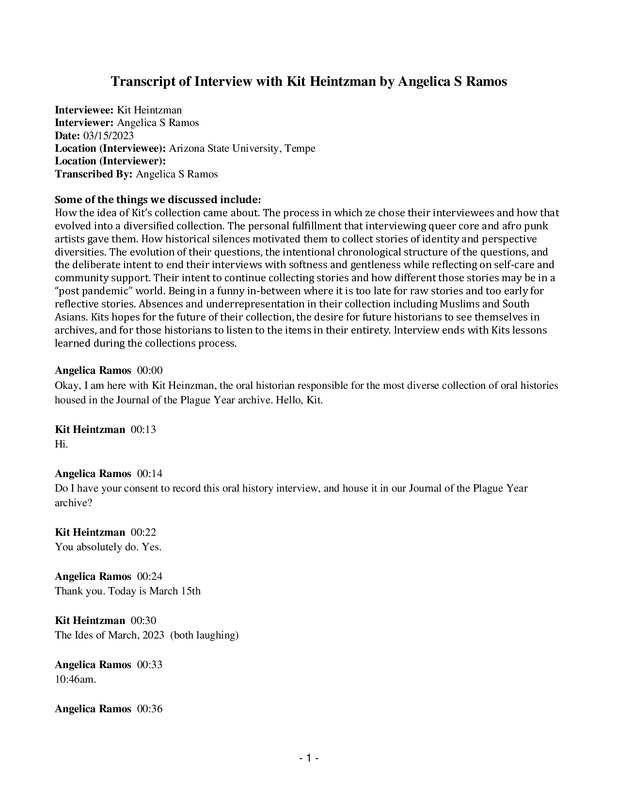
2023-03-15
Kit Heintzman is a recovering academic currently residing in Lenapehoking, who was trained in the medical humanities with a special interest in queer theory, animals, and the history of nationalism. Kit has developed a singular collection of oral histories of the pandemic for A Journal of the Plague Year, collected from a range of individuals with widely diverse experiences. That collection addresses significant silences surrounding the pandemic broadly and within JOTPY more narrowly. In this item Kit is interviewed by Angelica and Erin, both with Arizona State University, about Kits collection process.
-
2020-05-28
Schools were shut down, business were closing. My parents stood outside my living room waving as they dropped off Easter baskets for my children. The monotonous routine of my husband coming home from his shift as a police officer and bagging his uniform in a garbage bag in the garage so I could immediately wash them for fear he had brought home Covid. Two months passed of this until that dreadful day when neither of us could smell or taste anything. He had brought home Covid. At first, it felt just like a cold with the exception of the loss of taste and smell. But a few days into our positive results, my husband's symptoms became more severe. He began having trouble breathing at night. We had medicines and took precautions to get him through those nights. I was scared because we had two young children at home and they began to show signs of Covid as well. I didn't feel like I had anywhere to turn. In the beginning, you were told only to come to an ER if it was absolutely necessary and even then, the people who were checking into the hospitals were not checking out. It felt like a death trap to bring in my husband. Days passed and symptoms improved. We were lucky, it had passed. We had long-lasting effects when it came to rapid heart rates and regaining our taste and smell, but feel very lucky we eventually recovered.
-
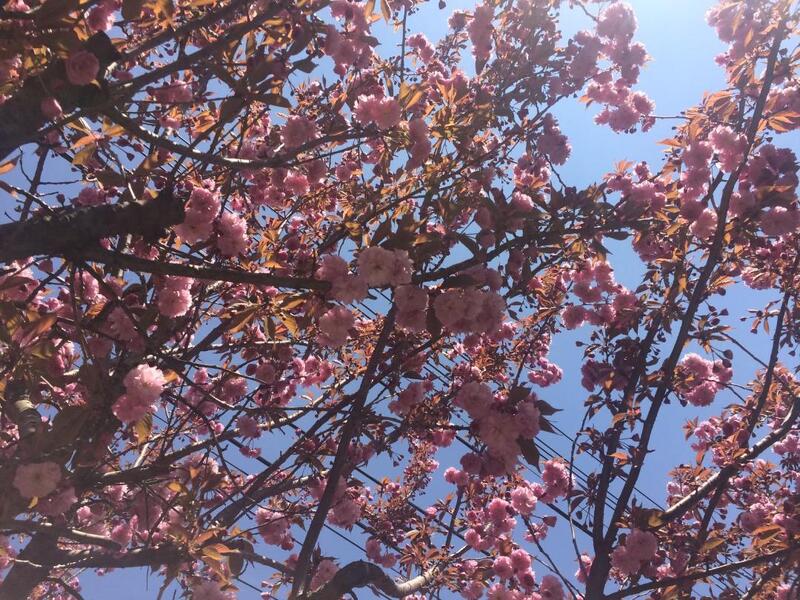
2023-03-25
“During the lockdown, it seems that everyone took on a small hobby to keep themselves busy. For me, I took on a couple to keep me busy. One of them included going for daily walks and taking photos of the scenery around me. I’ve taken walks even before COVID, but this was the only time where I really took my time and payed attention to my surroundings. I normally don’t bring my phone as that time is my 20 to 30 minutes away from technically, however I started to bring it along with me to take photographs of the trees blooming in spring and everything starting to grow and looking amazing. For the remainder of 2020, I kept to my hobby of taking photos and made sure to capture scenery I thought looked interesting. I especially made sure to snap photos in the same spots to capture what they look like in each one of the seasons. Luckily with it snowing weeks before Christmas that year, I was able to get a photo of one street during each one of the seasons. To me, they looked really cool!”
Photo by Kyle Collesano, April 19th, 2020 #lockdownstatenisland
-
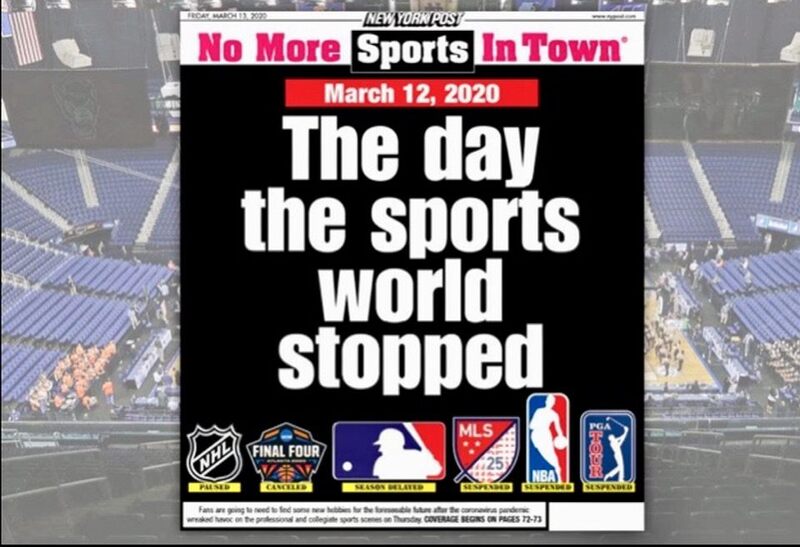
2023-03-25
This is a chronicle of the pandemic from March through December 2020. It shows how normal things were abnormal and yet somehow the same.
-
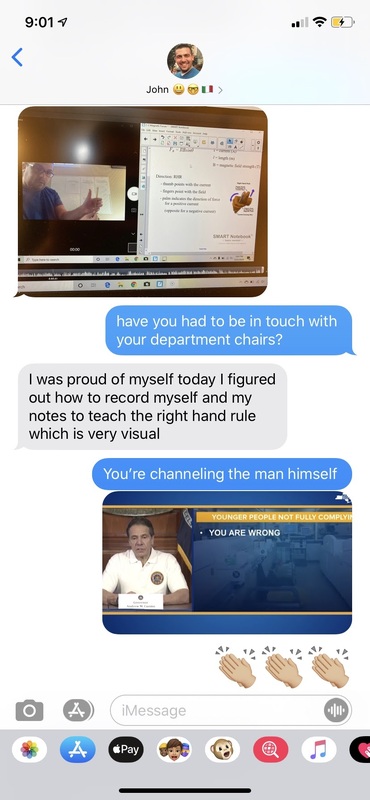
2020-03-25
My friend John is a high school math and physics teacher on Staten Island. On March 25, 2020 he sent me photo of his laptop screen. Schools had been closed for about ten days and he, like many other teachers across the state, had to improvise how to continue educating in this radically new reality. He wrote, “Proud of myself today. I figured out how to record myself and my notes.” I compared it to the setup of Governor Cuomo’s daily press conferences which were a unifying and relied-upon source of information in those early days of the pandemic. When I asked him to reflect on that lesson he said:
“That early in the pandemic I was lucky I was good with tech so I immediately started recording lessons for students to watch asynchronously. In my mind it was the best way to keep continuity. (I would bet at that time I thought we would be back in school before the end of the year). That lesson in particular is very visual (the right hand rule) so I wanted to figure out how to have notes on the screen and myself to be able to show how to use the right hand rule. I tried to do as closely, as I could, what I would have done in class. I tried to have the students continue hearing from me. The videos were posted so students could learn asynchronously. I did host some live sessions where they could ask questions on anything they learned. We could not mandate synchronous learning because families could have multiple students sharing a computer or even parents who now needed to work remotely, etc. That policy changed in Sept. 2020 when we gave out laptops so we could say you have your own meet at your normal class time.”
-
2020-05-29
Taking daily walks during the pandemic didn’t make me feel “healthy” or “well-adjusted”. I watched the way my neighbors and I would pull our masks up when we passed each other on the street. Saddening, on one hand; a show of communal care, on the other. I think it’s human to want to pull a silver lining out of a tragedy and I guess the silver lining here is that I had time to s l o w down and look at my community, not just the people, but the signs on storefronts, dishes of cat food next to porches, and yes, the outline of the Verazzano peeking out through the clouds hovering over Belt Parkway. I used to walk on this walkway when I was a child too, and though the pandemic has changed everything, the fishermen are still here, their rods propped against the rail. People are still riding tandem bikes. Still laughing, talking, breathing in the salty air.
-
2020-03
I finally became a video star.....that was never my intention when I started teaching fifty years ago!
I am an adjunct art professor. When lockdown came and I couldn't teach in person, I had to find a new way to teach my class.....Zoom felt too complicated to me so I communicated with my students via email and videos that my husband and I made in the basement! A 15 minute video took over 3 hours or more between the filming and the editing! In addition, I really had to work hard to find the best way to communicate-the most effective way to present the lesson, as no questions could be asked as I presented the material. It really got me to think and be very clear about the subject and the best way to teach it. Once in front of the camera, I made believe I was talking to my class and just ran with it! I felt comfortable once I started. It was funny though, as we had to carefully think about camera angles and outfits that worked well as I moved! After all, this was permanently on tape...And, I had to be brave! My Brooklyn/StatenIsland accent was forever heard, as well as facial features, expressions and body parts that have always plagued me be forever seen! Overall, though, a great experience!!!! Who would have thought that such an awful, disturbing period could bring about new, positive experiences! Ah, but that is life after all, isn't it?
-
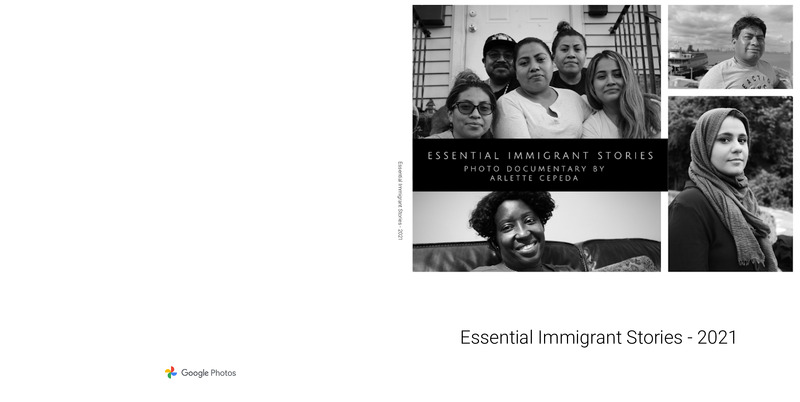
2021-09-11
Essential Immigrant Stories is a photo-documentary project by visual artist and photographer, Arlette Cepeda, that focuses on highlighting the challenges and opportunities the COVID-19 pandemic has created for Staten Island’s immigrant community members through portraits and accompanying stories. The goal of this project is to elevate and validate the immigrant experience and their impact in our Staten Island community. “Through portraits and accompanying short stories, I'm interested in documenting the experiences of the often neglected, silenced or omitted immigrant population of this particular north-shore neighborhood.” “It is my hope that this project can help create awareness, increase empathy, acceptance and understanding of our otherness, narrowing the divide and discrimination often faced by immigrants.” - Arlette Cepeda
-
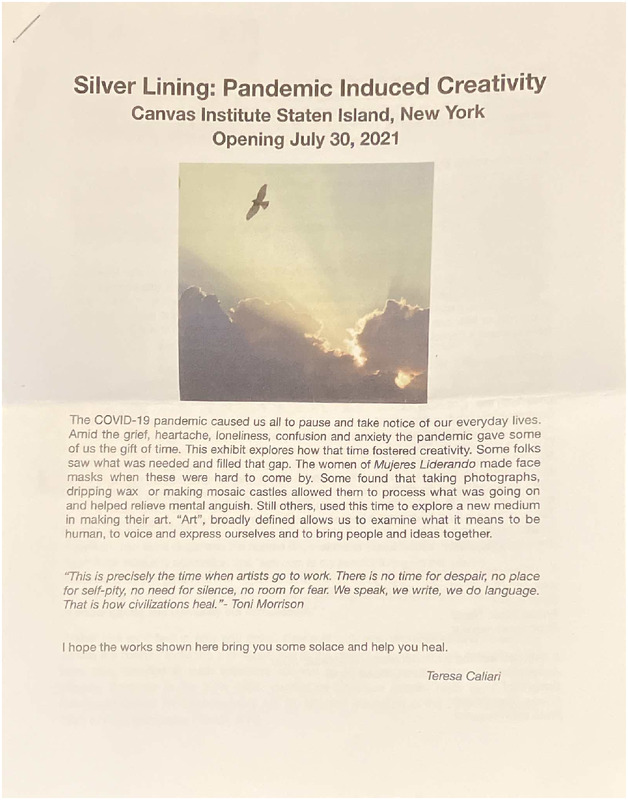
2021-07-30
I found myself doing “creative” things that I hadn’t had time for previously and so I asked Staten Island artists what they had created during the pandemic. For some it was a reaction to the politics of the time. For others it was an opportunity to try new media.
-

2020-03-16
When lockdown started, I was quarantining with my husband, our 2.5 year old daughter, and our elderly cat, Floofy. This series of images captures a year of my workspaces (March 16, 2020 to March 15, 2021). I worked all over our house. The living room when I was on kid duty. The porch when the weather was warm enough. A brand new desk when the porch got too hot. The bedroom when my husband, who had been laid of in March 2020, needed the desk to job hunt and eventually began doing off and on temporary work in December 2020. I returned to the office some of the time in September 2021. My husband is now fully employed again. Our daughter returned to pre-school in September 2020. Floofy died in January 2022. She had attended every work meeting with me.
-
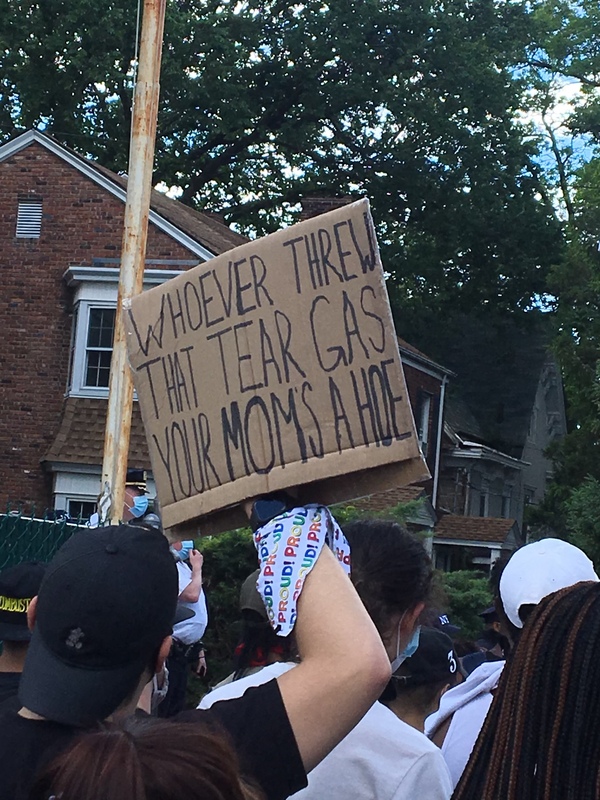
2020-06-09
“This is from a protest on June 9th, 2020 I went to, which was in protest of the police and George Floyd’s death. The sign spoke to me and it’s the only picture I have from that day. But I feel like I was part of history that day. It was the first thing I went to with my friends or people since the lockdown started. Before that, I was alone with my family and my thoughts. And so it marked the beginning of a new world of change that we embarked upon.”
-
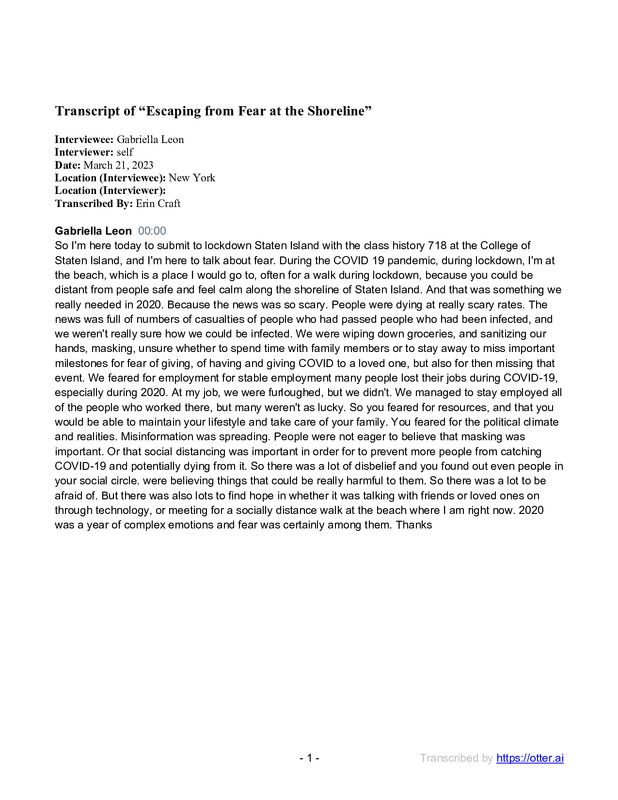
2023-03-21
Submission for #LockdownStatenIsland exploring Fear and the complexity of emotions during COVID Lockdown while at the beach - a place I visited often for a little peace and tranquility during that scary time.
-
2023-03-21
Since I am a homebody and like my solitude, the lockdown was not terrible for me, personally. I was thankfully able to work remotely, and used my sparetime, cooking, taking on line classes and learning about homeopathy which I use as my health path, but delved more deeply into it by taking on line classes. The meditation groups that I would attend in person, were able to convert classes to zoom, which was a truly wondrous thing. Other groups followed suit, and before I knew it, I was involved in groups all over the world by zoom - AMAZING! My cousins and I would meet every Sunday on Zoom to share experiences and catch up on "us". My mom who is now 95 was able to facetime with family several times a day (she was given an ipad by her grandson the year before) and it saved her from feeling isolated. Food deliveries were readily available, thanks to Pam Silvestri keeping us aware of the food community happenings. I realize many people had negative experiences, job losses, etc. or not able to cope, and I myself knew many people that passed during that time. I think this is a great idea to document the stories of the lockdowns and how it affected people in different ways. There is so much more to say, but I will keep it summarized and leave it here.
-
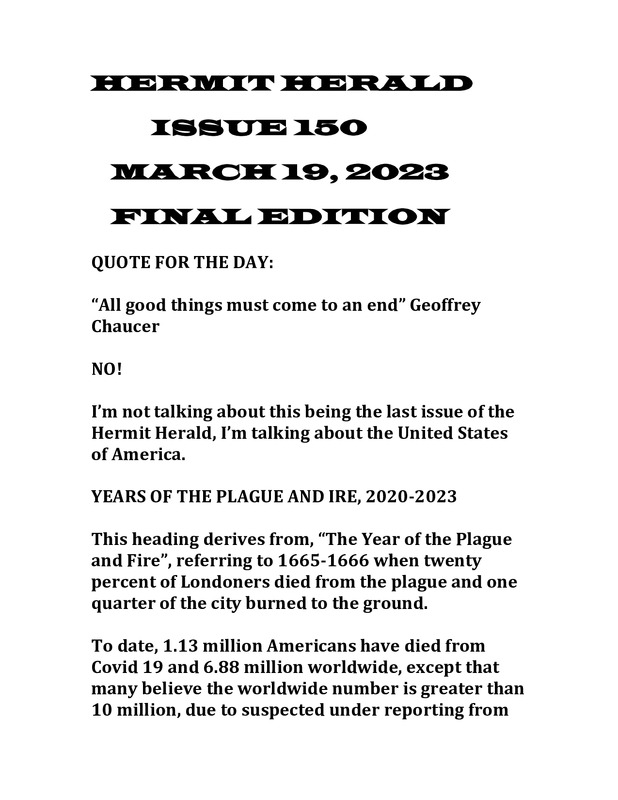
2023-03-19
Final issue, a three year review
-
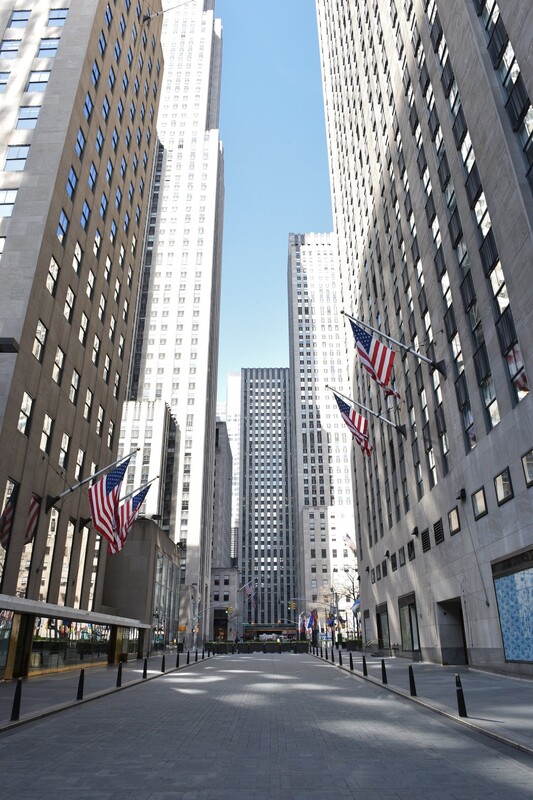
2020-07-27
During the height of Covid, when New York City first went into lockdown, it was surreal to say the least. I think the last time the city was so empty and void of life was 9/11, so to see it again in 2020 really highlighted just how severe the situation was. Two of my sisters, who are a nurse and hospital manager, talked about being in the city for work, and practically being the only ones working in person, and it feeling like some kind of post apocalyptic movie. I remember around May of 2020, I helped my other sister move out of her dorms at #NYU, and it took about 15-20 mins to get to the bottom of Manhattan (Union Square) from The Bronx, due to the lack of fellow cars on the road. To see such a highly populated and lively city such as NYC turn into a ghost town almost overnight was something of a shock. It was one thing to see photos, and speak on how insane the situation was, but to actually be in the heart of Manhattan at this time was… well scary. So, seeing such a busy area such as Rockefeller center be completely empty is insane to say the least, and brings up a sad reminder of just how bad things were in the initial stages of the pandemic.
-
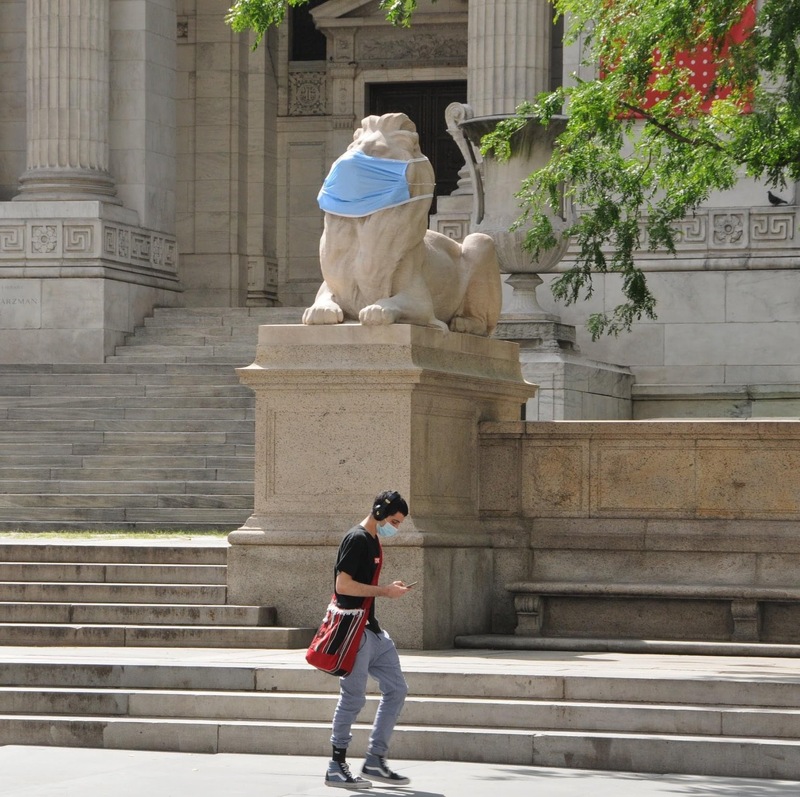
2020-07-27
The New York Public Library’s website explains, “During the 1930s, Mayor Fiorello LaGuardia named [the library lions] Patience and Fortitude for the qualities New Yorkers would need to survive the economic depression.” I remembered this fact and connected immediately with it the first time I saw Patience and Fortitude wearing their masks in solidarity with the New Yorkers they have watched over for more than a century. It struck me that we would need those virtues to make it through COVID-19 as well. “Those lion statues have seen New York struggle through and overcome many hardships from the 1917 Flu to the Great Depression to September 11th,” I thought. Things were grim in New York in 2020. We were the first to experience the horror that would eventually engulf the whole country. The infection rate was high, hospitals were full, people were dying. It was easy to despair. The masked lions were a powerful symbol of the resolve and resilience of New Yorkers and a reminder that this turmoil, too, would pass into history and the city - like the lions - would remain standing.
-
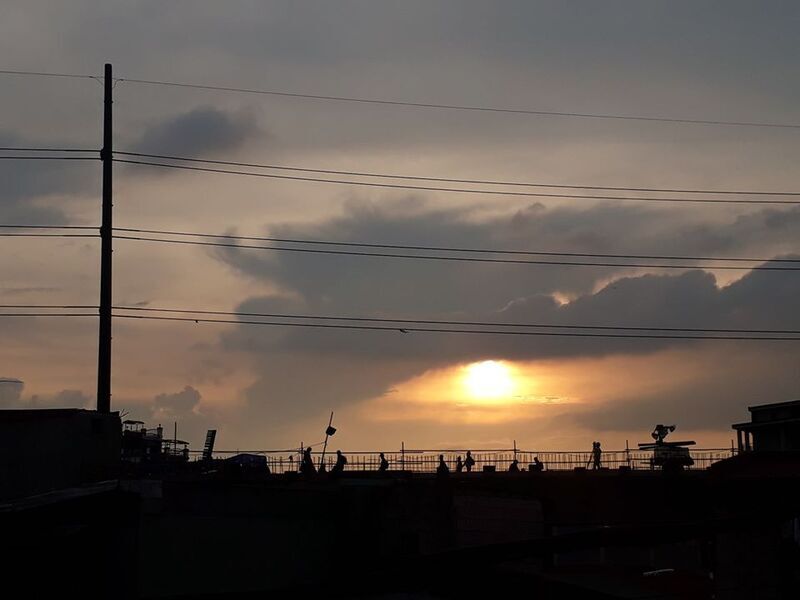
2023-03-13
This photo is from A Journal of the Plague Year in the Philippines, submitted by Mark Anthony Angeles on May 19th, 2020. I picked this photo because it connects to my experience from lockdown. The sunset to me represents an end of a chapter or era, as in, the end of my first half as an undergrad student. While it was stressful by end of sophomore year, I pulled through without any issues. But the light of the sunset to me also means that there is hope and that things will get better. That’s what I hope throughout lockdown, hope😌. #lockdownstatenisland
-
2020-05-02
This photo is taken from the CSI Public History Coronavirus Chronicle Facebook page. (May 2, 2020, author unknown)
I look at this photo and remember when social distancing was still fresh and new and everyone did it. Now, it feels like people are starting to lose that boundary of personal space and wanting to stand as close as they can behind you in a check out line. I remember actually enjoying the distance people were forced to take, and a part of me wishes social distancing was still in effect.
 12/11/2021
12/11/2021 12/08/2021
12/08/2021 12/13/2021
12/13/2021 12/13/2021
12/13/2021 12/06/2021
12/06/2021 12/08/2021
12/08/2021 12/05/2021
12/05/2021 12/10/2021
12/10/2021 12/07/2021
12/07/2021 11/27/2021
11/27/2021 12/10/2021
12/10/2021 11/27/2021
11/27/2021 12/31/2021
12/31/2021 12/12/2021
12/12/2021 12/14/2021
12/14/2021 12/02/2021
12/02/2021 12/14/2021
12/14/2021 12/03/2021
12/03/2021 12/12/2021
12/12/2021 12/15/2021
12/15/2021 2023-03-20
2023-03-20 2020-04-01
2020-04-01 2020-03-19
2020-03-19 2021-09-06
2021-09-06 2021-11-30
2021-11-30 2020-03-13
2020-03-13 2022-01-31
2022-01-31 2020-03-13
2020-03-13 2020-06-22
2020-06-22 2020-06-06
2020-06-06 2023-03-30
2023-03-30 2023-03-15
2023-03-15 2023-03-25
2023-03-25 2023-03-25
2023-03-25 2020-03-25
2020-03-25 2021-09-11
2021-09-11 2021-07-30
2021-07-30 2020-03-16
2020-03-16 2020-06-09
2020-06-09 2023-03-21
2023-03-21 2023-03-19
2023-03-19 2020-07-27
2020-07-27 2020-07-27
2020-07-27 2023-03-13
2023-03-13